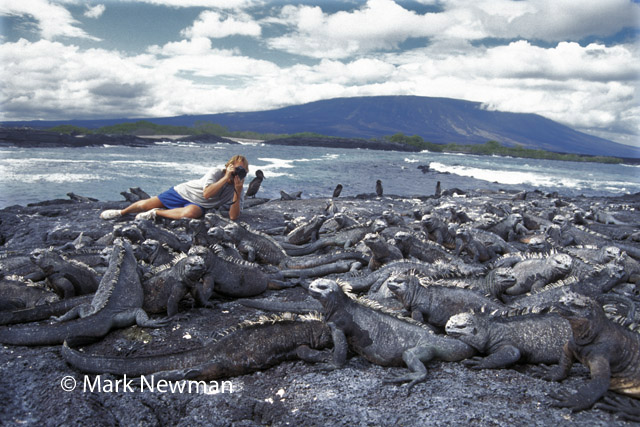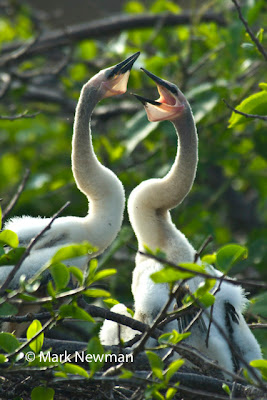It seems that recently I have been involved with books that have taken over fifteen years either to write or to think about writing. The idea for Golden, my novel about a wild horse, began as an idea in about 1994 and then was kept on the back burner until 2009, when I began writing the manuscript, finally completing it over a year later. My approach with Galapagos was different in that it began with a journal which I kept during my travels to the archipelago in 1996, and I actually began writing the book almost immediately upon returning to the US in March of that year. But here it is 2011 and the book is only now going into print (and ebook) after having gone through the final revisions in the past few months. Many times during this lengthy pre-publication phase the irony was not lost on me that it was starting to look like it would take me as long to get my simple Galapagos travels book published as it had taken Darwin to finally publish Origins.
(Map by Wendy Newman)
From the time of the end of his five year voyage aboard the HMS Beagle, Darwin took 24 years--until age 50--before getting around to completing On The Origin of Species in 1859. I used to think that that was an extraordinary and even irresponsible amount of time to take to complete a book. But then I saw the same thing happening to my work-in-progress as the years ticked by.
(Photo courtesy of Wikimedia Commons, public domain)
Charles Darwin 3 years after his long voyage; this portrait was painted about the time he conceived of his theory of evolution, at age 30 or 31.
Many books wind up being published posthumously. That was precisely what I was trying to avoid when I chose the path of self publishing this year. Several times in the past I encouraged my book agent to hustle a bit and try to find a publisher for Galapagos. The most recent excuse I heard from her for lack of success was in 2009, when she said that the publishing market was already saturated with Darwin-related works due to that year being the 150th anniversary of the original release of Origins. She told me, "Maybe in a few more years when things calm down." Two more years rushed by. I finally lost all patience this year and published the book myself through CreateSpace, Smashwords, and Kindle Digital Press (KDP). These options are available to any writer, for free, and make publishing a fast and streamlined process. You can have your book up and running in a matter of weeks.
My friend convinced me that using the iconic scientist's name in the title would make the book more marketable.
When I returned to my home in Alaska I mailed the manuscript to my agent in New York. She suggested changes and strongly recommended that I include photographs in the book. I resisted that idea, since my goal was to break into the writing world and I felt that utilizing photographs would be a distraction for the reader and go counter to what I was trying to accomplish.
Vermillion Flycatcher on Santa Cruz Island
But as the years rolled rapidly by and the book failed to be picked up by any publisher, my resolve softened
until I was adding photographs left and right to liven up the work and make it more saleable (I hoped). During that period my book agent retired so I switched to a new one. She suggested many text changes and had me really do a hatchet job on the original manuscript. The book shrank to one third of it's former length and came to include less of me and more of Darwin and a good number of photos, both my own and historic. Thankfully, the historic photos were all readily available for free from Wikimedia Commons. According to US copyright law, any creative work that was published prior to 1923 is in the public domain (such as the Darwin portrait included in this blog). There are companies out there trying to tell you otherwise and attempting to sell these historic images, but they are basically scamming and their claims to ownership have no legal basis. Wikimedia Commons is a terrific source of images for any writer who requires photographs to add to his or her manuscript.
Marine Iguanas at Punta Espinosa on Fernandina Island
Earlier this year I learned the process involved in self-publishing with my novel about a wild horse (Golden). After I had that project completed and the book for sale online at Amazon, it seemed that the next sensible thing to do was to take In Darwin's Footsteps off the back burner and feed the work into the same process. I told my agent what I was up to and she said I didn't need her any more and gave me her blessings. I then had a good friend do one final proof reading of the book (probably the dozenth by now). He found the usual assortment of typos which I corrected before emailing the finished work to a wonderful fomatter in Malta named Maureen Cutajar. I had her format for both ebook and print versions (they are two very different formats) according to the exacting specifications required by Smashwords and CreateSpace, respectively. She was busy so it took her about ten days to do the work and email the formatted versions back to me. Within an hour of receiving the formats I had them uploaded to Smashwords and CreateSpace, as well as to Amazon's KDP. After that the process pretty well runs itself, with all sales being taken care of online through either digital downloads of the ebook or print-on-demand paperback copies of the book being handled by Amazon.
Magnificent frigatebird with gular sac mating display on North Seymour Island
I now have one more backlogged manuscript to pull out of storage and feed into this same publishing whirlwind before beginning work on an entirely new book. The next book I write will not take fifteen years to publish.
Mark Newman













































